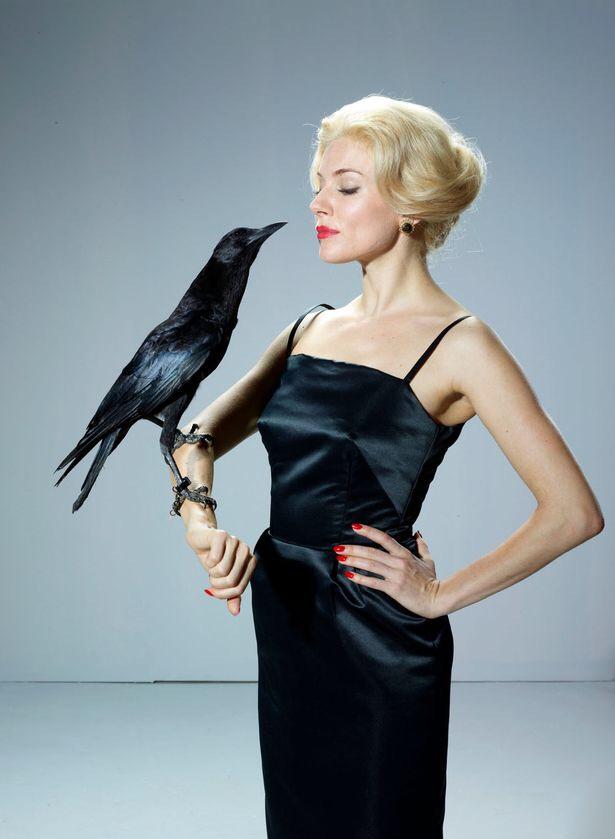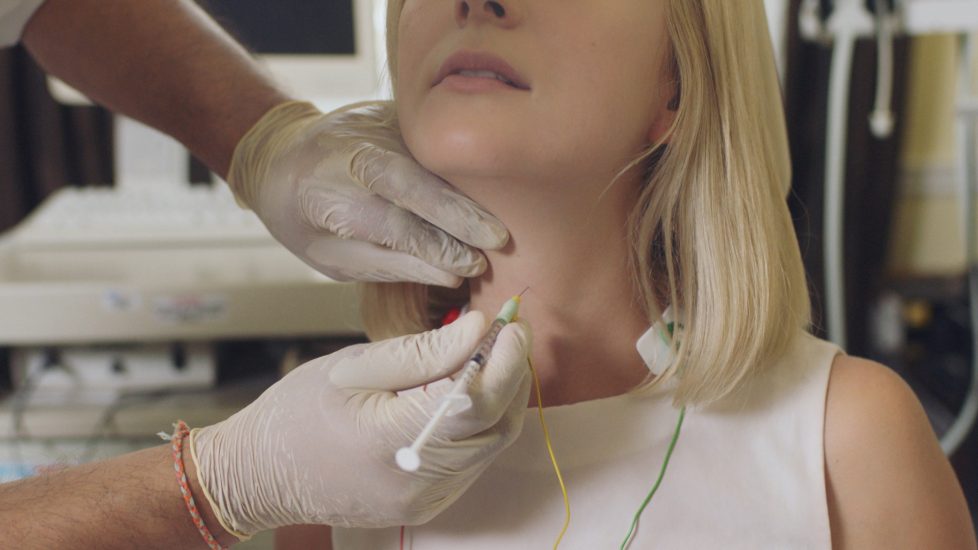
.
Marianna Simnett uses her body, and the bodies of others, as the raw material of her art practice. And the images are striking. She is young, conventionally attractive, blue eyed, and blonde—all things that she weaponises. In The Needle and the Larynx (2016), in which a doctor injects Botox into her throat in slow motion, she invokes an image of the ingénue—a vulnerable but desirous innocent, looking wide-eyed up at her lover. In Worst Gift (2017), she recalls Alice, peering through the looking glass at medical equipment and prepubescent men who are to receive the same treatment, which, in this alternative narrative, is denied to her. Later, she stares at the camera, a worm flicking between her lips; it’s both obscene and mannered. In The Udder (2014), a young blonde girl, Isabel, is perversely doubled, her other sexualised with lipstick. In one sequence, she holds a scalpel—like the disturbed blonde boy Oskar does in Tomas Alfredson’s film Let the Right One In (2008)—which she later turns on her nose. In Blood (2015), the blonde Isabel has a procedure on her nose, and, in her delirium, enters into an existential dialogue about biology and sexuality with a ‘burrnesha’, an Albanian sworn virgin. In social-media and performance images, Simnett is the witch, the vamp, the high-fashion model, in some cases cradling or wearing a crow, the key protagonist (or antagonist) in The Bird Game (2019). In others still, she is animal. In Tito’s Dog (2020), she makes herself over as a German shepherd, her dark roots showing, playing interspecies make-believe within an aesthetic built on girlish make-believe. Alongside the bright clear blonde sits sexuality, corporeality, animality, contamination. There’s both opportunity and threat.
And she is drawing from a clear tradition. I am taken with the sense of blurring or exchange that happens in so many stories about blondes, beasts, and bodies. This happens at the level of narrative, of course, but also representation and form. In these fairy tales of femininity, be they traditional or contemporary, identity is malleable, contingent. Bodies double or swap, and uncanny doppelgangers insinuate themselves into familiar situations. Embodiment is not fixed. Instead, metamorphosis and rupture are the norm. Often these women don’t have given fixed names or use pseudonyms as protective colouration. Human and non-human animals encounter one another, coming into literal or abstract alliances, into odd combinations. Throughout, there is no stable original, only layers of representation. As such, these lines of identity are as crazed and interconnected as cracks in a broken mirror. Horror and delight walk hand in hand.
This is because of what we can make of the figure of the blonde. In From the Beast to the Blonde: Fairy Tales and Their Tellers (1994), Marina Warner notes that, from the seventeenth century, in English, the term ‘blonde’ suggested sweetness, charm, youthfulness, and lacked vampish overtones until the 1930s. It implies both beauty and light; note the resonance of the word ‘fair’. She writes, ‘Blondeness and beauty have provided a conceptual rhyme in visual and literary imagery ever since the goddess of Love’s tresses were described as xanthe, golden, by Homer.’ This ‘colour fulfils a symbolic function’—it is ‘a blazon in code’ that wraps up ordinary and popular materials of the everyday into ‘moral and social terms’. No wonder, she suggests, the ‘Nazi’s Aryan fantasies were partly rooted in this ancient, enduring colour code which cast gods as golden boys and girls and outsiders as swarthy’. Elsewhere, she observes that ‘Golden hair tumbles through the[se fairy] stories in impossible quantities’—note Cinderella, Rapunzel, Goldilocks—such that ‘Among the heroines of fairy tales only Snow White is dark’, and that is because her story requires it. It is her mother’s wish. We have then, in the mythic figure of the blonde, an archetype that speaks youth and beauty, often purity, drawing from fantasy. But, like Alice, she hovers at the edge of Wonderland, always-already topsy turvy.
Here, I want to address four of the many faces of this blonde archetype— the dream, the muse, the star, and the void. Some of them are referenced directly in Simnett’s works—she is nothing if not a skilled magpie, lining her artistic nest with shiny things, images plucked strategically from film and art, stories kept alive in their retelling. Others are clearly sisters to her characters and images. But all are part of the great pantheon of mythic, yet uncertain, blondes.

.
The Dream
In Disney’s 1959 take on the French fairy tale Sleeping Beauty, princess Aurora is blessed at birth with beauty and song. She is also cursed to die at the spindle of a charmed spinning wheel by bad fairy Maleficent, rightly angry that she was denied an invitation to the christening. Baby Aurora is whisked away for protection by mildly incompetent good fairies. She will live incognito, in the woods, as Briar Rose, until she’s married at the age of sixteen. Note the double names, the double identity, things are immediately uncertain. The film is animated, beautifully, to recall the flat planes of a stylised storybook come to life. We are in the realm of fantasy.
We hear, again and again, that her hair is as gold as sunshine, her lips as red as roses. She is a natural phenomenon, as benign as the dawn for which she is named. What’s important is that this blonde isn’t really a person: she is currency. She has exchange value—that in marrying the prince, to whom she was betrothed at birth, two kingdoms might unite. Her safety isn’t for her own benefit, but for the security of the realm. Good thing she doesn’t seem to have any ambitions of her own.
You may know the famous scene in which woodland creatures, our beasts,are drawn to her song, her charm, her poise, before acting as matchmaker. They steal the cloak from the nearby prince, who’s out for a forest ride, forming an absent man-thing, a spectre, with whom she dances. Her song ‘Once Upon a Dream’ uses a melodic line from Tchaikovsky’s ballet and has gone on to be the de facto Disney theme. She dreams of a man, or a something. Who knows what those three good fairies have been telling her as she grows up, alone, out in the woods.
Enter Prince Phillip, cutting in on the dance. He’s a creeper; he pounces. The man replaces the beasts who make up a man, because he, too, is entranced by the dream—the voice, the face, the lips like roses, and the blonde, blonde hair. Why have a person when you can have—and be—a dream? What is love at first sight if not a form of enchantment. After, she demurely retreats, promising to meet him again later; neither of them knows the other’s true identity. The part that always unsettles me is when the woodland creatures make way for the Prince and the girl, frightened, looks at them for help. Who is this? Is she safe? The owl who makes up the ghostly beast-man’s head lifts its wings in a cocky shrug—whatcha gonna do? Princes gonna prince! It’s a tiny betrayal, but why not pass her on to the strange man in the woods? Isn’t that what’s supposed to happen, just a bit early?
From here, things go downhill, magic goes awry, she’s been rumbled. Maleficent, ever the bad bitch, the only woman with any grit in her personality, finds a way to entice the girl, in a dreamlike state, towards a dreaded spindle. All she must do—it’s only a small thing—is touch a little prick. She faints, she sleeps—as do people in many of Simnett’s works. Sleeping Beauty is now a ‘sick girl’. To protect the realm, the good fairies cast ‘extreme narcolepsy’ on the kingdom. The prince—off sulking, thus untouched by the enchantment—must fight his way to the newly revealed princess, waking her with love’s true kiss, setting the world to right.
Of course, as in so many of these stories, she is even more lovely inert than awake—why have a real woman when you can live once upon a dream? There’s a whole history to this: think of Coppelia the dancing doll, Pygmalion falling in love with his statue, Olimpia the alluring automaton in E.T.A. Hoffman’s short story ‘The Sandman’, the gynoid Ava in the film Ex Machina, or even the beautiful anatomical Venuses that were shipped from town to town in eighteenth-century Italy. But she plays her passive part. He kisses her, the kingdom wakes up, they marry, the kingdoms unite, the economy is saved, and they twirl, round and round, doomed to live happily ever after.
We know that fairy tales aren’t nice—that Disney has done a pretty good patch-up job on stories that are about sex, death, and dismemberment. Sleeping Beauty doesn’t have a fixed name; her identity is unstable. She doesn’t have a personality; her identity is a blank slate. And, with blonde, we have light, luminosity, the ideal heroine. There is the implication of pale skin, thus youth, and a lack of outdoor work, thus nobility. But also, historically, blonde was the colour of virgins’ hair. The perfect woman is a dream, nameless fiction, waiting to be had.
Most importantly, the thorns, Briar Rose, make way for the dawn light, Aurora. If you are au fait with some of this imagery there are some pretty big red flags. The hero must hack his way with his big strong sword through the thorns, removing or subduing them, to get to the soft prize within, those lips red as roses! The story of Sleeping Beauty is one of the best metaphorical representations of the toothed vagina, the vagina dentata, a widespread mythic trope that frames female sexuality as dangerous, voracious, and monstrous. It can be misogynistic, when aligned with patriarchal disgust for women’s sexual autonomy. It can also be subversive, when used to destabilise those power dynamics. Sleeping Beauty contains a gleeful undercurrent of threat that cannot be excised; maybe one day, in the retelling, the prince won’t be so lucky.
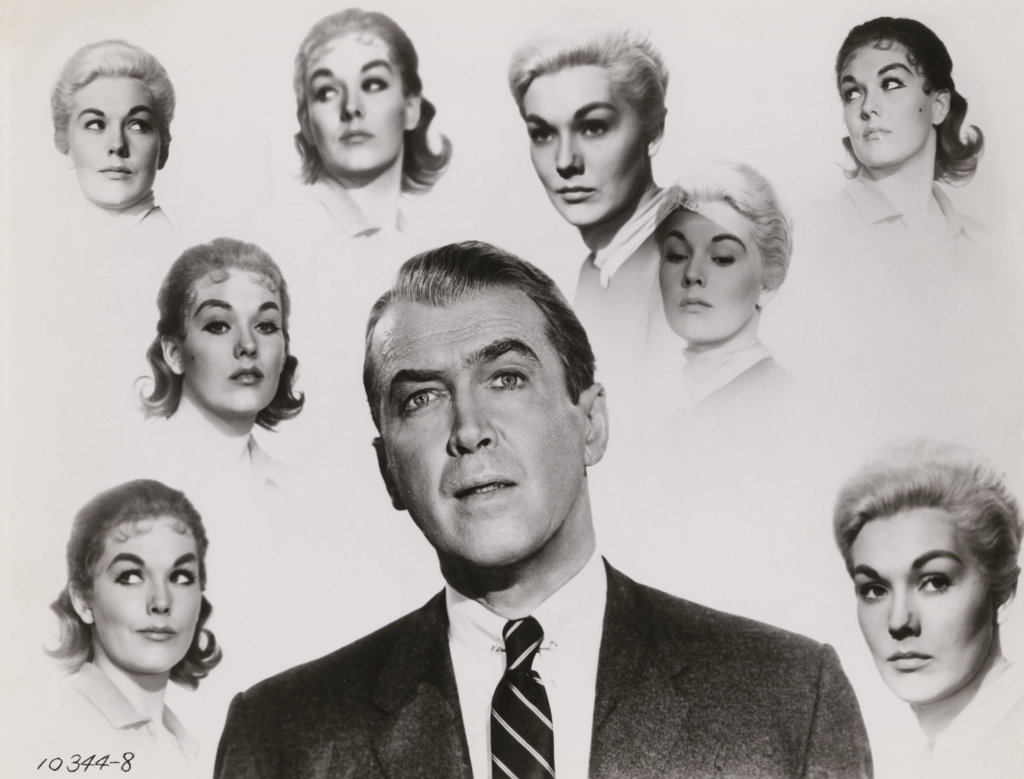
.
The Muse
Alfred Hitchcock had a thing for blondes: warm blondes, soft blondes, icy blondes; blondes who were distant, aloof, sophisticated, and poised; women whose simmering sex appeal was only matched by their sense of mystery. Beneath her perfectly styled hair and her crisp clothes, the ‘Hitchcock blonde’ is complex, cunning, and duplicitous—seductive and threatening. She is often paired with, contrasted against, some kind of brunette. In Vertigo (1958), the icy blonde, played by Kim Novak, is a really brunette in disguise. But plain Judy is forced back into the role of fictional blonde stunner Madeleine by obsessed cop Scottie (James Stewart), one facet of a woman exchanged into another, a dream dragged into reality or manipulated into submission because of a man’s sadistic obsession. In Hitchcock’s films, we can’t trust the blonde—there is always more to her that meets the eye. So why not punish her?
And the eye is important here. Hitchcock’s films play with the language of cinema as the language of voyeurism. For what is film, but peering into a world, without that world knowing we are doing so? We might look at something because we are fascinated by it, and it gives us a deep, almost erotic pleasure—something called scopophilia, where you demystify something threatening by gazing at it like a fetish object. We may also engage in voyeurism—a secret look in which the power balance is all off, when the viewer takes pleasure in subjecting the unaware object of the look to a penetrating, punishing, and controlling gaze. If you’ve done Film 101, you’ll know I’m talking about the work of seminal film theorist Laura Mulvey. Her famous 1975 article ‘Visual Pleasure and Narrative Cinema’ broke down the inherently patriarchal language of classical Hollywood narrative film’s objectification of women, the way women connote ‘to-be-looked-at-ness’—a dynamic that is exemplified and knowingly leveraged in Hitchcock’s films. In the history of classical Hollywood narrative cinema, men actively drive the narrative; we follow them and we look with them. Women are such a spectacle that they arrest the action of the film; we stop, stricken, and luxuriate in their soft-focus image.
Voyeurism is central to the plots of many Hitchcock’s films. And later, of course, these women are brought back into line, either through their gentle, coy domestication or their violent death—ends on a spectrum. People desire these women, and often hate them for it. In Simnett’s The Needle and the Larynx, for instance, we must ask ourselves—what pleasure are we gaining from the image of a needle being inserted into a woman’s throat? And what happens, when that woman, looks straight back out through the camera, challenging us instead of supplicating?
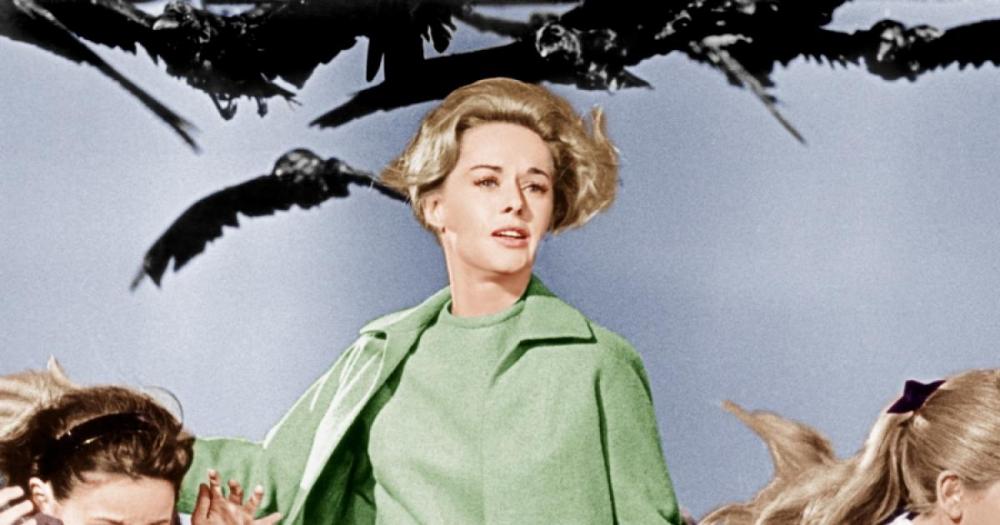
.
One of the most famous Hitchcock blondes is the terrific Tippi Hedren, a successful model who was ‘discovered’ by Hitchcock. He moulded her as an actress, but became obsessed with his muse, becoming abusive and controlling. When I look at the birds in Simnett’s The Bird Game, Wrong Gift, and related media, I think of Hedren in The Birds (1963), a raw, enigmatic film based on a Daphne du Maurier story. Wealthy socialite Melanie Daniels comes to Bodega Bay, north of San Francisco, to deliver a pair of lovebirds. She’s a practical joker who initially hides her identity. She’s there to flirt with a lawyer, Mitch, she’s just met in town. Desire is everywhere. When Melanie meets schoolteacher Annie, Mitch’s ex, the sexual chemistry is so raw it looks like they want to rip each other’s clothes off and bang against the letterbox. But, along with Melanie, comes a series of inexplicable bird attacks. They are horrific, visceral. The film remains terrifying.
It’s too simple to say that the birds represent sex, punishment, or repression. It’s more complex than that. The violence and the unknowable, non-human nature of bird intelligence is beyond our understanding. But an uneasy dynamic fuelled by desire is flagged immediately. In the opening sequence, Melanie walks down the street, and a young boy wolf whistles at her. He might as well be a Tex Avery cartoon, with his eyes popping out of his head and his tongue rolling out. She smiles at him, appreciative, for why shouldn’t he whistle?—she’s a babe!—but then she turns to look up and out, as a flock of birds circle above a statue, their presence a portent. She enters a pet shop where birds—not domesticated but captured—crowd cages. Their noise is like nails on a blackboard. As both Simnett and singer-songwriter Aldous Harding have asked, in different ways: what if birds aren’t singing, but instead screaming things at us that we can’t understand? Later, when she arrives in Bodega Bay, townsfolk stare at her as she gets out of the car, her platinum hair, furs, and heels all out of place. It’s clear that they want her, and they hate her for it. And, boy, does she get punished, ending the film tattered, her blonde hair messed up, face covered in blood, all that confidence knocked out of her, as Mitch drives her slowly away from the bay, birds as far as the eye can see.
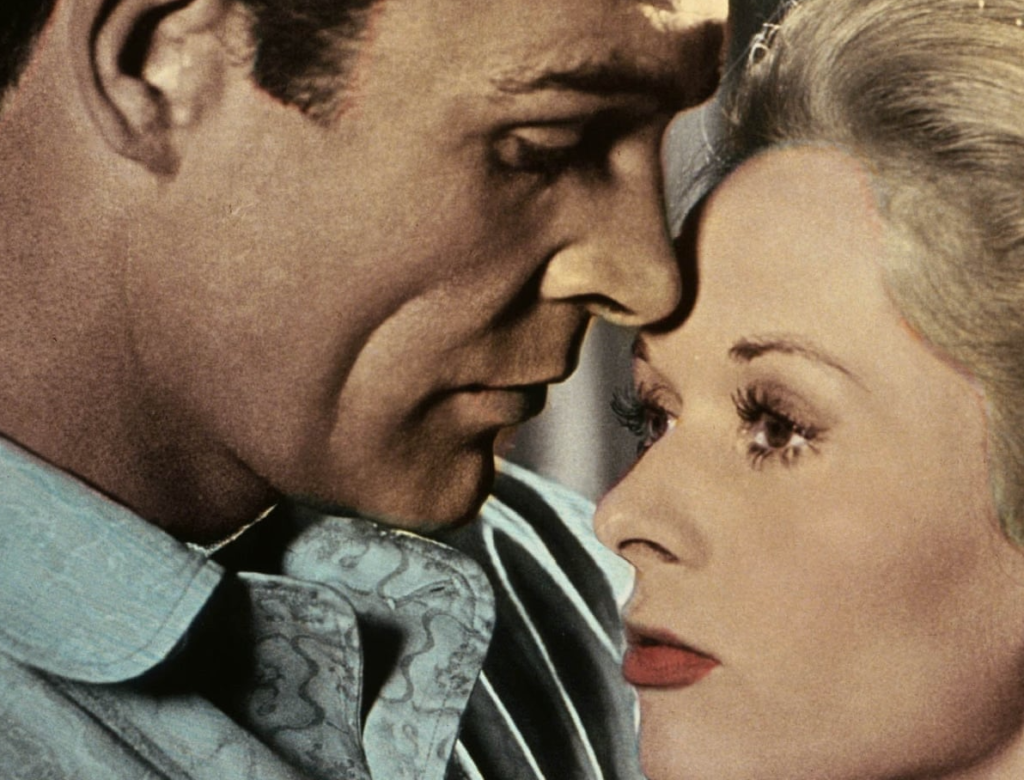
This is not Hitchcock’s only film in which blondes, and beasts, and bodies all come crashing together. In Marnie (1964), a film I find repulsive, Hedren plays a charming serial thief. Again, her blondeness is key to her character, her desirability. We see her first from behind as she completes a con, her hair dyed dark. But when we see her face the first time, she arrests the action, flipping her newly-washed blonde hair back, staring out at us. Like the other blondes, her identity is in question, for she has multiple pseudonyms. She also has serious childhood trauma, and she is increasingly framed as a wild, unstable animal who needs to be brutally domesticated so that she doesn’t have to be put down, so to speak. The man for the job is Sean Connery, as the domineering, rapey Mark Rutland, a creeper whose interest in zoology helps him identify and dismantle her animal impulses. It makes me queasy the way the film shifts our viewing position, and thus our sense of identification, from her to him.

.
And those birds, and all that peeping, are explicit in Psycho (1960). Norman Bates, a psychotic motelier with a split personality, secretly watches as blonde Marion Crane, played by Janet Leigh, undresses. Treacherous Marion is travelling under a pseudonym; she has stolen a lot of money and is on the lam. Norman, too, is a creeper—a running theme, it seems. The motel is his own little voyeur’s nest. We, the spectator, peek with him through a secret hole in the wall, and are invited to take note of her pale skin, her pointed bra. We are aligned with his eye, invited to feel what he feels: desire, cruelty, disgust.
Note the pictures of birds that sit on the wall of Marion’s room, because there are birds everywhere in this film, in people’s names and in lines of dialogue. Norman surrounds himself with taxidermied songbirds, game birds, and birds of prey mounted mid-swoop, as if they are attacking him in the frame. He talks of feeling trapped, as a stuffed owl (a stand-in for his dead mother’s malign influence) hovers over him. That is, repressed psychotic Norman likes to stuff birds—a double entendre if ever I heard one. Later, in one of cinema’s truly iconic scenes, Marion is stabbed to death in the shower, the screeching strings shrieking like Norman’s birds as her blood pools and slips down the drain. She stares back at the camera, eyes blank. Goodbye body, goodbye blonde.
Hitchcock said, in a TV interview on CBS in 1977, that ‘Blondes make the best victims. They’re like virgin snow that shows up the bloody footprints.’ But did he though? I’ve been looking for the source of this quote, digging around on the University’s database and in our library, and I can’t find it. It’s specific enough in its seeming provenance to seem true, but only appears on spammy quote websites and in popular-press articles. In one case, I found it an academic book that cites, of all things, an unverified entry on Wikiquote. Oops.
I like the idea that it’s apocryphal—that it contains the ring of truth, even if it was never stated. Being shared so many times, uncritically, brings it into the world, reinforcing Hitchcock’s myth, the myth of the blonde. But I also like that, in The Birds, it’s as if blonde Melanie, witch-like, can summon the creatures, that she’s somehow elemental; that the birds covering the town as her broken body is driven away aren’t an enactment of violent displaced desire, but are traces that she’s left that can’t be scrubbed away.
Read Part Two
—Erin Harrington
Erin Harrington is a senior lecturer at University of Canterbury Te Whare Wānanga o Waitaha. She is the author of Women, Monstrosity and Horror Film: Gynaehorror.
